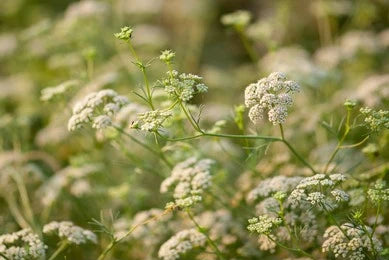Cumin (Cuminum cyminum) is a tiny annual herb that grows to a height of 30-50 cm. It has alternating, compound, filiform segmented leaves with sheeting bases. The blooms are tiny and white and appear in compound umbels or umbrella-like clusters. The flowers have both male and female components, as well as an inferior ovary that develops into a distinctive fruit known as a cremocarp. Fruits are greenish in color, turning grey when ripe, tapering towards both ends, and coated in papillose hairs. Though these grain-like fruits are called seeds, the genuine seeds are contained within them and emerge only after germination via fruit wall collapse.
Cumin seeds are rectangular in shape, longitudinally ridged, and yellow-brown in color, similar to other members of the Umbelliferae family such as caraway, parsley, and dill.
Cuminaldehyde, cymene, and terpenoids are common chemical components of cumin. It includes 2-4% volatile oil known as cumin oil.
General Description
It is a spice cum herb, one of the most popular spices used in Indian cuisine. We frequently add cumin or jeera when cooking (especially in Indian kitchens), but why? Is it due to taste, or is there another reason? Actually, it gives flavor and scent and is used as a spice. It also has other qualities like a digestive aid. All food ingredients are regarded as medicines in Ayurveda since they help the body in a similar way to cumin. So let's explore some additional uses for cumin.
The seeds have carminative, fragrant, stomachic (excellent for stomach), stimulative, and astringent characteristics. Nature is refreshing. In Sanskrit, cumin is known as Jeeraka, which is derived from the word jeerna, which implies digestion. So Jeerak means digestive, and it aids in digestive problems.
According to Ayurveda, jeeraka or Jeera has a bitter flavor with a heated property and can remove vata and kapha doshas while causing pitta. It is astringent, astringent, delicious, digestive, fortifying, and light for digestion, as well as an aphrodisiac. It is used to cure a variety of ailments such as indigestion, dysentery, enlarged spleen, flatulence, and vomiting.
Classification
Botanical name - Cuminum cyminum
Kingdom - Plantae
Sub kingdom - Viridiplantae
Division - Tracheophyta
Class - Magnoliopsida
Order - Apiaceae
Genus - Cuminum
Species - Cyminum
Family - Umbelliferae
Habitat
Cumin requires a hot climate to thrive at a temperature of roughly 30 °C. China, Egypt, India, Mexico, and North Africa are where it is indigenous.
Other Names
Latin name - Cuminum Cyminum
Common name - Jeera
Sanskrit name - Jiraka
English name - Cuminum seeds
Hindi name - Safed jeera, jeera
Kannada name - Jeerige
Malayalam name - Jorekam
Telugu name - Jeelakari
Bengali name - Jeera
Marathi name - Jire
Gujarathi name - Jeeru
Tamil name - Cheerakam
Ayurvedic Properties
|
|
Hindi / Sanskrit |
English |
|
Rasa (Taste) |
Katu |
Pungent |
|
Guna (Physical Property) |
Laghu, Rooksha |
Light, Dry |
|
Virya (Potency) |
Ushna |
Hot |
|
Vipaka (Post-Digestive Taste) |
Katu |
Pungent |
Effects on Doshas
Kaphavatahara is responsible for increasing pitta dosha in the body and pacifying the vitiated Kapha and Vata doshas.
Practical Uses
- It aids in digestion and appetite enhancement.
- It is highly helpful for nausea and vomiting.
- It helps in the treatment of leucorrhea, piles, and skin conditions.
- It has aphrodisiac properties that help men have more libido and sperm.
- It is excellent for the eyes.
- It provides stamina and vigor and is extremely helpful in the treatment of fever (Jirna Jawar or Chronic Fever).
- It also encourages mothers to breastfeed.
- Additionally, it protects the heart from illnesses and promotes heart health.
- It is extremely helpful for flatulence, bloating, and diarrhea.
- Additionally, it helps with diabetes.
- It significantly strengthens immune capacity.
- It encourages salivary secretion and stimulates the taste buds.
- It is an excellent natural antioxidant.
- It aids in the treatment of respiratory disorders such as TB.
- It lowers cholesterol levels and aids in weight loss.
Part Used
Seeds, Fruit
Dosage
½ - 2 gm.

